The Promise of Vertical Farming
Our relationship to food, agriculture, land, and rural areas is about to change dramatically
This is the 1st of 2 articles on vertical farms. Article 2 here and article 3 here.
15% of all habitable land—about the size of Russia1—is used for crops.

That has been growing consistently over the past few thousands of years.
A huge part of that land2 used to be like this:
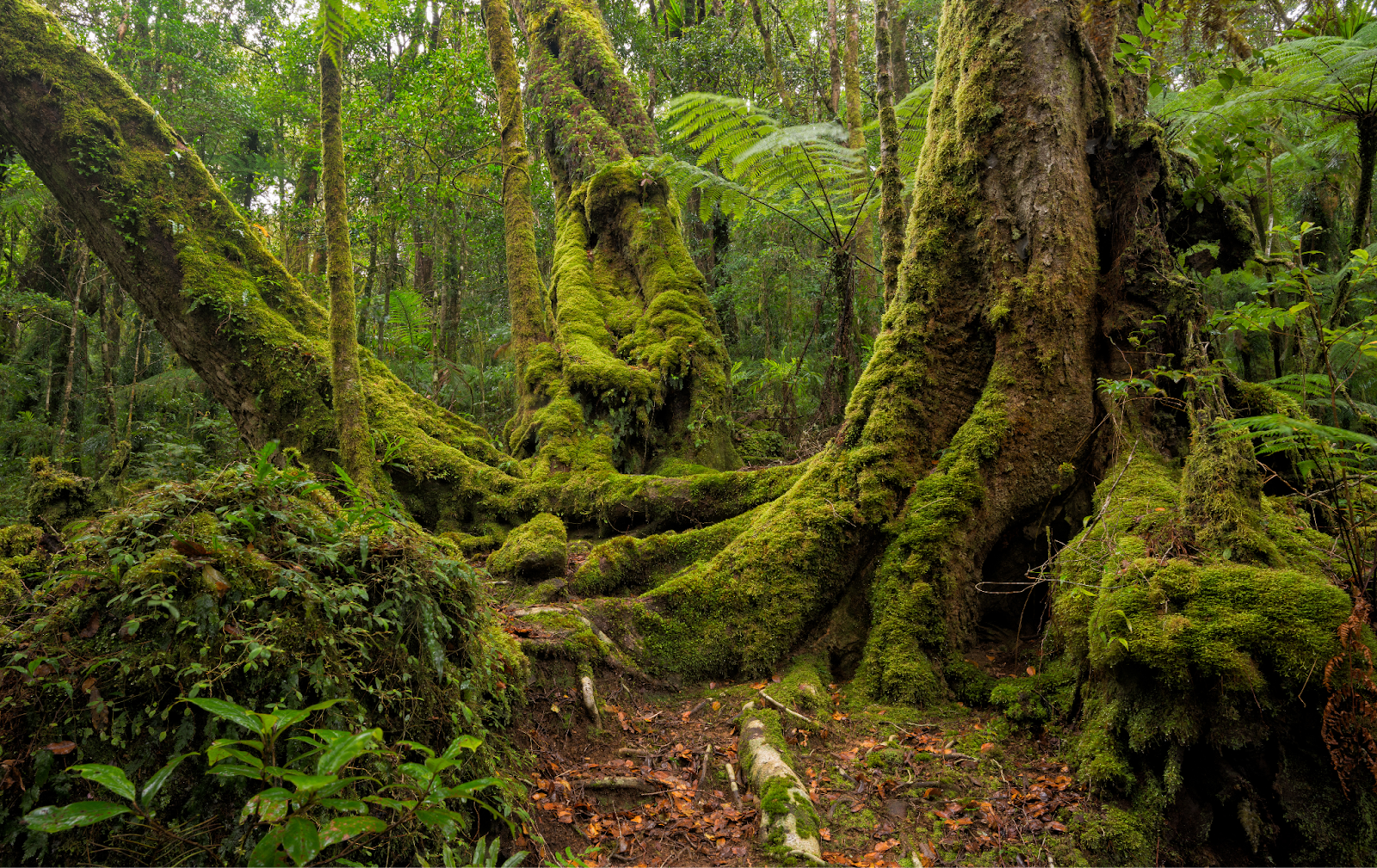
And now is this:
But we don’t have much land left that would be good for agriculture. As the human population continues growing this century, will we keep burning more forest to make room for our hunger?

What about fresh water? We’re already short, and tensions are growing to compete for the little water we have. This is a problem, since 2.3 billion people live in water-stressed countries, and 70% of global freshwater is used for agriculture.
What if we could eliminate all these sources of scarcity?
What if we could rewild most of this cropland into forests and other natural habitats where native plants and animals can thrive?
What if we used some of that land for anything else we might want, like wildlife reserves, national parks, more cities, more solar farms, and more beautiful human habitats?
This increase of supply of available land would also reduce real estate costs. How would that additional affordability help families?
If we used 20 times less water to grow our crops, how would that affect water scarcity?
What if, at the same time, we could produce more food, of higher quality, greater diversity, and more cheaply, so that everybody could get sufficient food at predictable prices?
What if we could do it with less pesticide and herbicide? Could we eliminate all the endocrine disruptors we consume today?

What if we could achieve all that while at the same time reducing waste and pollution?

What if this ended food shortages, and geopolitics were no longer decided by which country controls which crop?
We can achieve this through vertical farming.
The Promise of Vertical Farming
In the last couple of centuries, cropland has grown, but the world population has grown much faster, which means we have been consistently improving our farm productivity. Today, a human needs half the land he needed 60 years ago to survive.
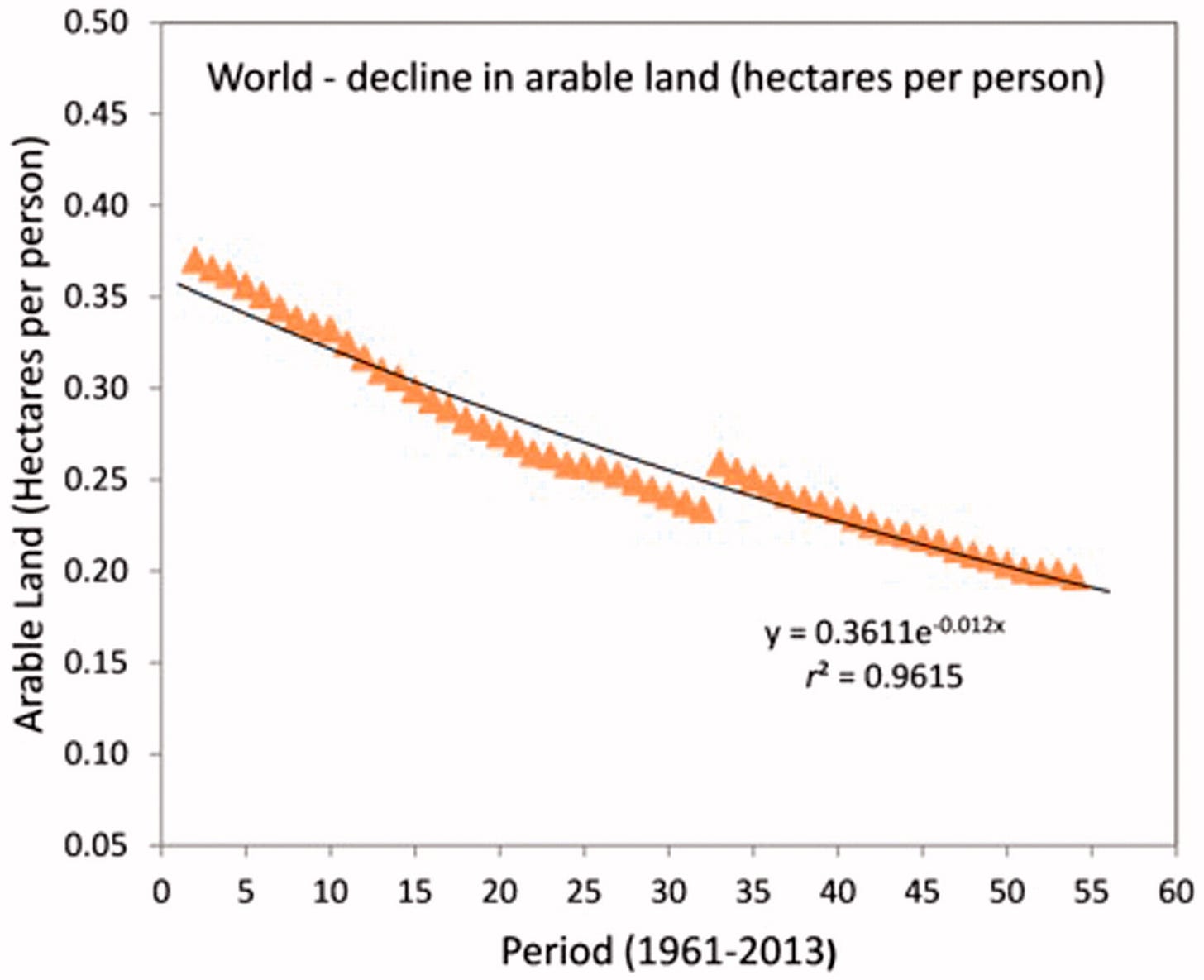
What if we shrunk that to nearly zero? That’s the promise of vertical farms.
They are indoor spaces with stacks of growing plants. The space has its light, temperature, humidity, nutrients, and water tightly controlled.

Unlock Land Limits
Today, the amount of food we produce is limited by the amount of land dedicated to it. Vertical farming has already released this shackle because we can stack floors of plants:

Imagine skyscrapers where plants reach the sky:

And it’s not just the number of floors. You can also pack more plants into the same space, because you can use artificial lighting to increase the energy they receive, while also bathing the plants in nutrients, without the need for soil.
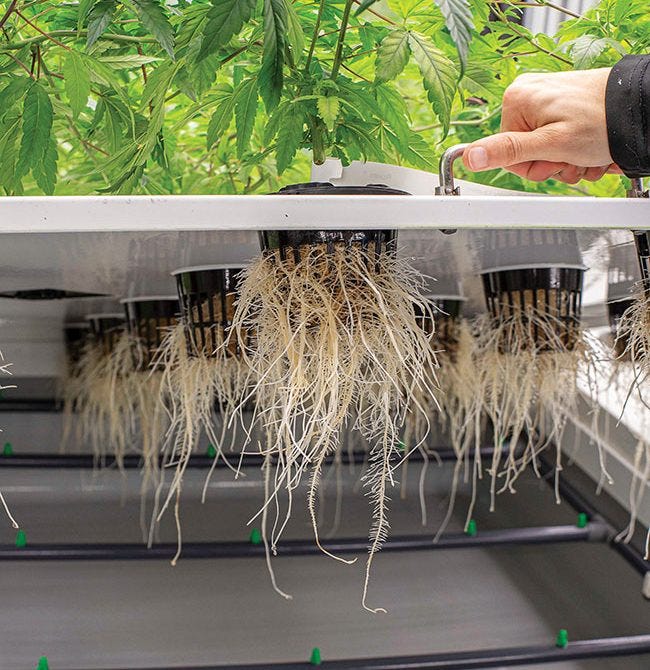
And then since you control the environment, you don’t need to wait for the right season, the right amount of sunlight, the right temperature or rain. You can have perfect harvests year-round.

The more these processes improve, the better the productivity. Today, computers can control:
…illumination, carbon-dioxide levels, humidity, air temperature, root-zone temperature, and the acidity and dissolved-oxygen content of water delivered to the roots, as well as its nutrient content and any other aspect of its chemistry.
Plant growth is monitored by web cameras linked to software that detects leaf edges and color differences, and by sensors that can detect areas of active photosynthesis. After harvesting they are examined by lidar (the optical equivalent of radar) to record their shape in detail, and by gas chromatography/mass spectroscopy to understand their chemical composition.
Of particular interest are matters such as flavor and astringency, that are governed by chemicals called secondary metabolites. These are often parts of plant-defence mechanisms, so in one experiment the computers are looking at the effect of adding crushed arthropod exoskeletons to the water supply, which may mimic attack by insects or mites. The hope is that this will change flavors in controllable ways.
Where traditional farmers might have benefitted from one or two harvests a year, greenhouses have allowed them many more, and this benefit is even more true in a tightly-controlled vertical farm. For example, one Canadian vertical farm produces 20x more vegetables than outdoor farming per unit of land. A Japanese one produces 100x more with 40% less energy and 80% less food waste. A Singaporean one produces nearly 200x more.
Where floods or droughts or frost or heat waves might kill harvests, that won’t happen in vertical farms.
This means we will be able to grow all the food we need. No more famines, no more hunger, no undesired nutritional deficiencies, no more unaffordable food. It also means we release a planetary boundary that limits how many people can live on Earth. No more anxiety about a growing population.
Doing this in buildings instead of on the ground in open air has many other advantages.
Waste Less Water and Fertilizer
Most of the water used for irrigation ends up in the sea: It filters through the ground and into rivers instead of feeding plants.
In vertical farms, no water escapes. 95% of the water is reused—and the remaining 5% is what plants use to grow. There is no waste.

Less Pollution
This will reduce pollution too.
When you hear about fertilizer runoff, that’s because rainwater carries fertilizer with it and ends up in rivers and lakes.

This is impossible in a vertical farm, where water and fertilizer are carried in a closed-loop circuit. What a plant doesn’t use is carried to the next one or recycled.
Crop production accounts for ~10% of all greenhouse gas emissions.3 About 1.5 percentage points come from fertilizer production.45 Another chunk from machinery use. Another chunk comes from transportation. 85% of global emissions of toxic nitrous oxide (N2O) are produced by microbes that digest some fertilizer intended for plants.
Replace open fields with closed environments close to cities, and you eliminate all the polluting waste and most of the transportation pollution.
Fewer Pesticides
Since we’re indoors, the environment can be completely controlled and pests kept out.
Plants can focus their efforts on growing rather than fighting off pests. Meanwhile, all the pesticides and herbicides we bathe them in will become obsolete, and our produce will finally be clean of these poisons.
They are not just poison for us. Plants also suffer: About 30% of production is lost to pesticides each year. Yet another source of waste we will eliminate.
Closer to Cities
Today, most production happens hours or days away from the place of consumption.
That’s because you can’t grow crops year-round in the same place, or there might not be enough room for them. But in vertical farms, you can grow wherever you want.

Anywhere means you can grow food close to the cities where it will be consumed, shrinking the time to market, the miles that food must travel to reach the table, and the amount of time it must be refrigerated or frozen.
This will make produce fresher and reduce transportation pollution, but it will also shrink gaps between supply and demand: In the future, production will adapt more quickly to the demand of the market. No more surges in prices.
This proximity will also allow plants to be selected, not because they can withstand the hard, modern processes of agriculture, harvest, pesticides, and cold storage, but because they are delicious and nutritious.
OK, I’m SOLD, Tomas! When can we have our indoor farms? Are they everywhere yet?
Not quite. What’s the holdup?
The Sun Ceiling of Vertical Farming
Today, vertical farming is more expensive than the outdoor variant. Why? It helps to understand what farming is at a fundamental level, and how it’s improved vertically.
So what is farming? It’s growing:
Plants adapted to an environment
With specific nutrients from the ground
Energy from the Sun
Water (and air) from the sky
Then working to adjust everything to our desires.
Most of these farming resources used to be impossibly tied to land: You got whatever sun, nutrients, and water that were available where the land was.
Work depended on humans, and humans were only available where agriculture was productive to begin with. So although work was a bit more flexible, four of these elements were tied to the land.6
Humans were able to untie water from land somewhat, through irrigation. But not by much: They could only divert the course of rivers small distances.
Then, over millennia, we optimized nutrients little by little through things like crop rotation, legume mixing, human and animal fertilizer, and later, fertilizer at a large scale.
It took thousands of generations to painstakingly optimize plants through selection:

As the human population grew, we added more work to fields. Then, we domesticated draft animals and invented things like heavy plows to optimize the amount of work we invested in farms.
Lately, we have been able to optimize all these elements faster and faster, tweaking water, nutrients, plants, and work with greenhouses, precision analysis of moisture, small sprays of water every few minutes, genetic engineering, precision fertilization, drones, satellite scanning, CO2 addition to greenhouses…
Here’s the one input we have yet to optimize: energy.
It has always been whatever the Sun wanted to give a certain plot of land.
Today, that is still the main limitation of indoor and outdoor farming, but it’s about to be released.
The Energy Problem
Here is the cost of vertical farming compared to outdoor farming as of 2020:

I was surprised when I first saw this:
In the US, adding land for outdoor farming is basically free of cost. That’s why cropland expands so fast: It costs very little to add more cropland!
Water is the biggest cost! A bit more than half the cost of farming. Hence the water wars in the US.
Labor costs are the other big expense…
Energy costs very little, because most is fossil fuels for machinery, I suppose.
Conversely, for vertical farming, land and water cost virtually nothing. Those are the promises of this new type of farming.
But energy and labor costs are through the roof! Until they shrink dramatically, vertical farming has no future.
Luckily, we can do better than nature for energy.
Energy & Light
Why are plants not black? Black is the absence of light, so if plants absorbed all the light they could, they would be. That’s why solar panels are black. So why are plants green instead?
As I mentioned in a footnote of Solar Energy Solves Global Warming:
We didn’t know until recently. It turns out that plants don’t just optimize for peak light captured, but also variance. There’s usually plenty of light, so what they try to do is get a constant stream of energy, not one where they get huge peaks and valleys.
Here’s the energy of the Sun, broken down by its color (that is, the frequency of its photons’ waves), compared to the parts that plants absorb:
Notice how they absorb no green light? That’s why they’re green. Instead, they absorb two peaks of light, one blue and one red. That’s the light they like. What color is formed by blue and red light?
You might have noticed the purple lights in the pictures throughout the article. They’re formed by a combination of blue and red lights that delivers exactly the wavelengths that plants need to grow quickly, but no more.
Crucially, these two peaks of blue and red account for only 1-2% of sunlight energy, and that gives us an opportunity for arbitrage.
Solar panels are much more efficient than plants.7 They can capture 20-40% of the energy from the Sun. Batteries can also release the vast majority of the energy they store. Let’s assume that, together, solar panels and batteries will be able to capture, store, and release about 30% of the Sun’s energy they receive.
Then, we’d need to translate that into red and purple LED light. Their efficacy8 varies, but it’s likely that we will reach about 95% in the coming years.9 Which means that, overall, capturing the Sun’s energy through solar panels and translating it into LED light will be about 15x more efficient than outdoor farming, where the Sun hits plants directly. As efficiencies of panels, batteries, and LED lights improve, we might get into the 20-40x range.
The constant drop in costs of solar panels, batteries, and LED lights means building all this infrastructure for vertical farms will be cheaper and cheaper.

Currently, vertical farming uses 10x more energy than outdoor farming, and lighting is the biggest share of that energy. Slash that cost by 12-20x, and we can achieve parity with outdoor farming—or even cheaper.
LED lights have other advantages over the Sun. Since we can use them 24h,10 we can grow food constantly, the way they do it in Alaska during their never-ending summer days.
Since LEDs don’t emit much heat at all, they can be put very close to plants’ leaves so that every photon is used.
We can also tweak the quantity and wavelengths of light to improve the quality of produce, making lettuce crisper or softer.
A dose of green at an appropriate moment produces a higher yield. A timely spot of infrared can improve the quality of foliage.—The Economist
Spectral sensitivity may also extend beyond the visible wavelengths and into the ultraviolet and infrared bandwidths with potential effects on growth rates.—Source
And we haven’t even started genetic engineering for plants to adjust better to indoor conditions!
It’s clear to me that at some point in the coming years or decades, the cost of energy for vertical farming will be so low that it will be comparable to—or even cheaper than—outdoor farming.11
Human Work
Remember, labor is the other big source of costs of vertical farms compared to outdoor ones in the US:

This cost needs to be divided by 5 for vertical farms to reach cost parity with outdoor farms. How will we get there?
Well, consider that we’ve been optimizing outdoor farming for a very long time:
It’s taken us 170 years to go from 70% of the population working in agriculture to only 1-2%. But we’ve figured it out, with trucks, tractors, harvesters, threshers, drones, and all sorts of machinery replacing humans, and by changing the layout of plants to adapt them to our machines and increase yields.
Instead of dividing costs by 30-70x, we only need to cut them by 5x in vertical farms to get the job done. Of course, right now the job is super labor-intensive:

But we’re just starting! We don’t even know what light and fertilizer and heat and humidity are optimal for each plant. We’re doing heavy science! But as we figure all of that out, we will need fewer scientists—replaced by AI. We will optimize the plant holders for optimal growth and harvesting. We will automate most of the process, from seed to packaging.
We are inventing the tractor for vertical farms. It will take time, but the work needed for vertical farms will shrink every year until vertical farming is cheaper than outdoor farming.
Takeaways: The Future Is Vertical Farms
Vertical farming has tremendous advantages compared to traditional, outdoor farming, stemming from the fact that you can control everything in ways that are impossible outside. You don’t waste anything: water, sunlight, fertilizers… But you also avoid pesticides (and pests), as well as any problems arising from bad weather. All while generating less pollution and using less land.

If we get to a 20x improvement on light from solar panels + LED lights compared to outdoors, and we unlock every other limiting factor to growth (fertilizers, water, etc), you can imagine at a high-level a shrinkage of the area needed for farming of about 20x.12 With other sources of energy, we could shrink it over 100x.13
What I’m getting at is that we will soon be able to decide what to do with a large proportion of the 15% of habitable land that we’ve dedicated to agriculture until now.
Not only that, but with vertical farming, every country will be able to produce its own plants, reducing international dependencies.
It will take decades to fully transition, but the progression is unstoppable.
How will we get there?
What is happening to current vertical farming companies?
What kinds of places will harbor the first winning vertical farms?
What kinds of plants are we growing today?
Are we making money from them?
What other plants will we be able to grow in the future?
How do naysayers criticize vertical farming?
How will this influence geopolitics?
That’s what we’ll discuss in this week’s premium article.
This is the 1st of 2 articles on vertical farms. Article 2 here and article 3 here.
A total of 16 million square kms. About half of that is for food we eat, 35% for feed for livestock, and 15% for non-food crops like cotton, bamboo, lavender, tobacco, biofuels, etc.
Different papers disagree on the amount. Some say 50%-75% of present-day cropland was covered by forest, while others say it was only 25-50%. Let’s assume it was in the middle, at 50%.
7% is crop production, and 6% is all food transportation. I’m assuming crop transportation is about half of that.
The Haber-Bosch reaction uses energy (usually fossil fuels) to transform N3 from the air into forms of nitrogen that plants can consume (generally NH3, NH4, or NO3). Nitrogen is the single most important element in fertilizer.
Traditional farming wastes about ⅔ of fertilizer. Since vertical farming utilizes all fertilizer, we could reduce CO2 consumption by 1% simply by moving from traditional farming to vertical farming. When the remaining fertilizer is produced through solar energy and green syngas rather than fossil fuels, we will shrink that to zero.
All but the actual plant variants, which could come from faraway as long as the climate was the same.
Let’s pause for a second here. Holy cow, human engineering, in a matter of decades, has done better than evolution for billions of years at harnessing energy! What a sobering fact.
The share of energy you give to the LED that turns into useful light.
We will get there sooner rather than later, because Haitz’s Law claims that every decade, the cost per lumen (unit of useful light emitted) falls by a factor of 10, and the amount of light generated per LED package increases by a factor of 20, for a given wavelength (color) of light. I also like this comment highlighting LED efficacies. The takeaway is that the efficacy is 20-95%. Since we’re only starting, I assume this will approach the higher range over time. This paper explores efficacies of far-red to far-violet light. The gist is that we know a ton, but we keep improving.
Apparently we don’t. Plants need their equivalent of sleeping, but it appears to be only a couple of hours, so LEDs can be on for 22h a day growing plants.
Vertical farms will always use more electronic equipment and LED lights, but they will save on transportation cost and on the energy needed for the Haber-Bosch reaction for fertilizers, or the mining of phosphates. Therefore, I think it’s very possible that at some point this century vertical farms will consume less energy than outdoor farms.
This is not exactly right, because some of the light will be used at night, and lots of other sources of productivity will be tapped
For example, nuclear uses 300x less surface area than solar panels, so it could enable skyscrapers full of plants with barely any footprint.



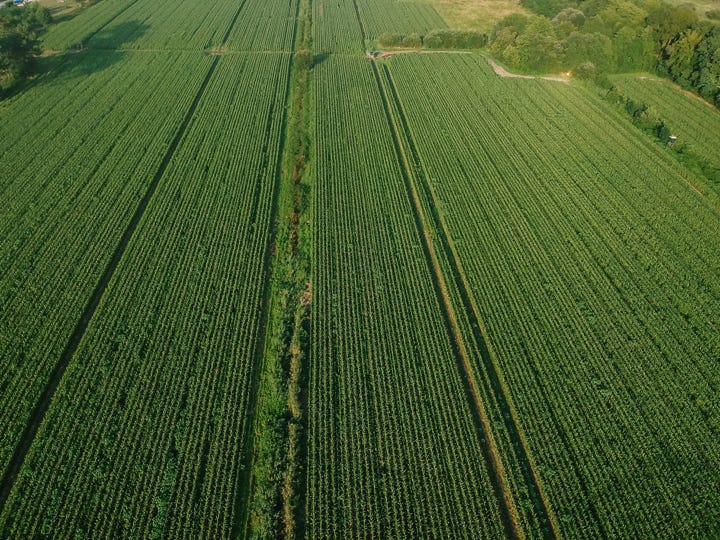




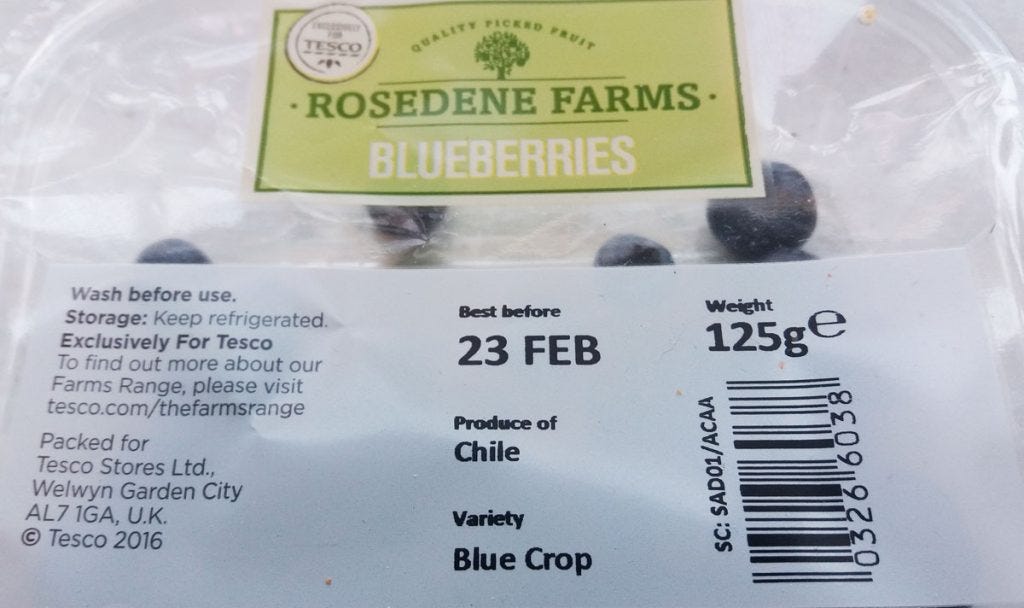




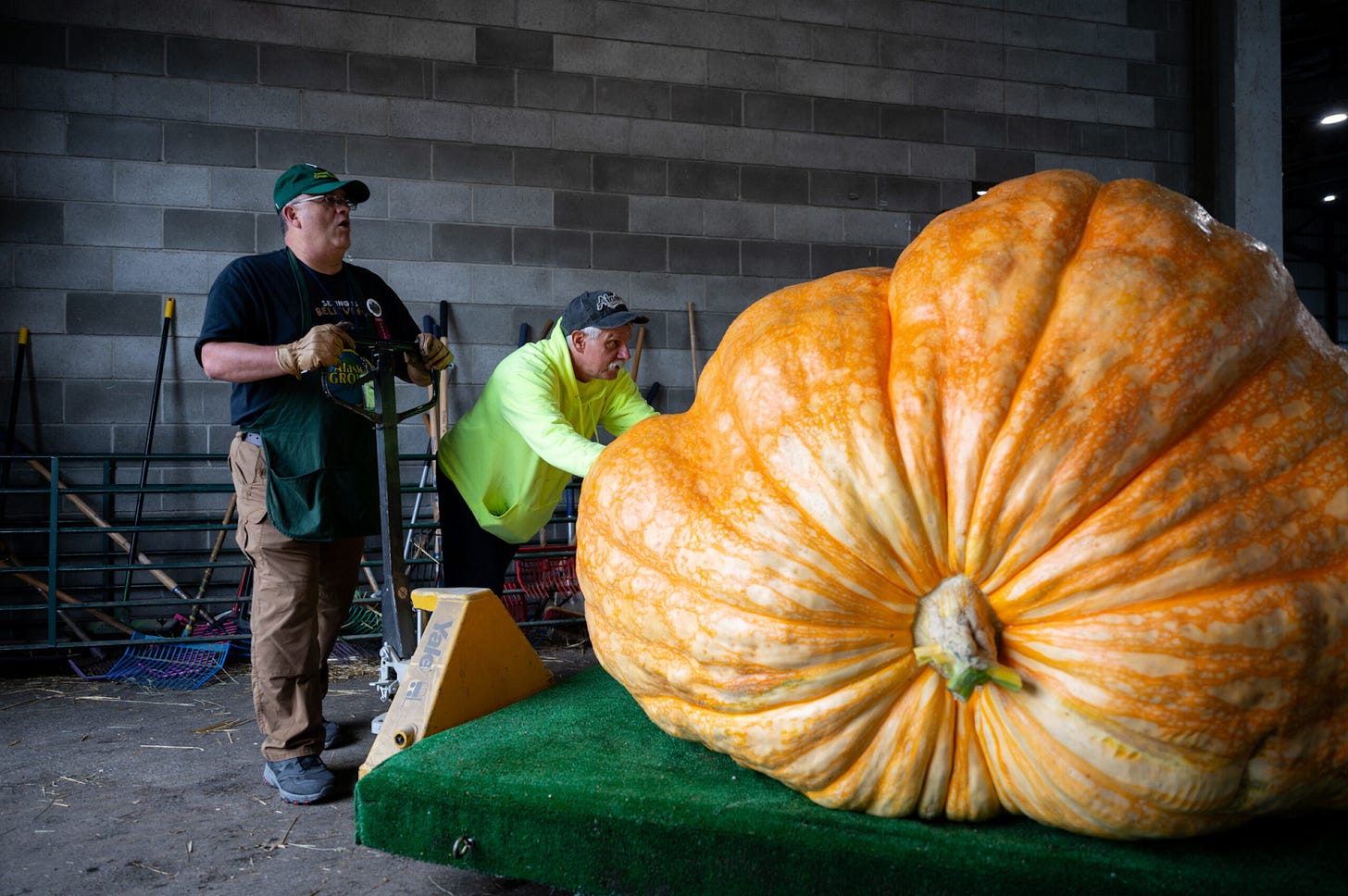
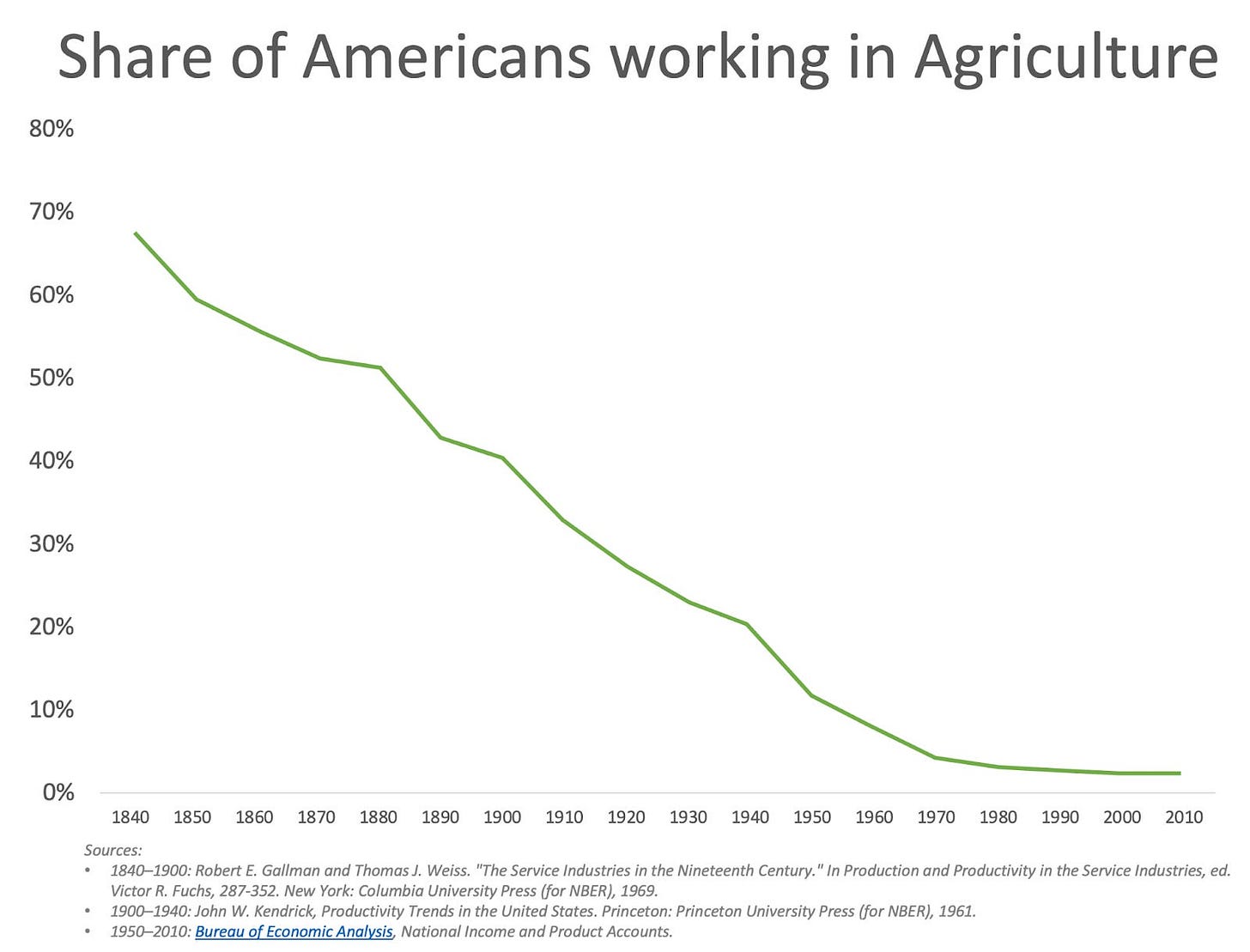
I think you’ve fallen for some of the deceptive marketing of vertical farming proponents.
The first problem with this article is that most of the comparisons are with open field “dirt” farming, so while vertical farming may use 20x less water than dirt-farming, it doesn’t use 20x less than greenhouses. And if you’ve ever been to a modern greenhouse, you’d can, and in many cases do, use many of the other techniques you mention - such as automated control of temperature and humidity, integrated pest management, massively reduced labor, and with all the other benefits - such as reducing runoff etc.
In particular your energy graph is massively deceptive since it doesn’t compare to Greenhouses.
To simplify it, high density cropping uses around 40% of the light incident on any one point, so lets say you stack 15 layers high as you do in the first photo - so for every meter of floor area you have 15 m2 of crop. You need light equivalent to 15*40% = 600% of the incident light, but you can’t get it to the plants since they are stacked, so you replace it with LEDs. Lets assume those LEDs are 100% efficient (they aren’t) but generated by solar panels + at 30% efficieny (though 16% is MUCH more likely) that would mean you’d need an area of solar panels of 15*40%/30% = 20m2 of solar per m2 of vertical farm. That of course is 1.3x as big as building a greenhouse - i.e. replace every 20m2 of solar panels (glass on frames) with 15m2 of greenhouse (glass on frames) and you’ll get better results financially and from the sustainability perspective. And at the more realistic 16% efficiency for the solar+batteries+LEDS its 2.5x as much land.
This is why so many vertical farms are in trouble - it doesn’t live up to its promises, either from a business or sustainability perspective when compared to greenhouses. This of course is also why Vertical farm proponents compare themselves to dirt farming rather than state of the art greenhouses - a deception that has unfortunately propogated into this article
Hydroponic Vertical farms have all the nutrient density issues of hydroponic greenhouses, the better (e.g. dutch moving gully) systems use dirt instead of hydroponics, but this is much harder to do that in a vertical environment.
Land in the middle of cities is very valuable, but you can put greenhouses in the urban fringe with many of the transport benefits, even more so with something like Bluesmartfarms.com’s integrated fish/plant systems.
Interesting and very relevant choice of topic!
Thoughts:
1) OOM improvements in food product to biomass ratio possible. Most of current agricultural production is not food, but biomass waste. End state might be only the desired fruit or leaves being left, nourished by artificially generated plant juice.
2) Labour costs will drop with scaling+usual efficiency improvements. Then, remote controlled worker robots steered by workers from low cost countries will reduce labour costs in high income countries. Finally, AI controlled robots will eliminate most of it.
3) As always, cheap&clean energy is the base of everything. Solar&Nuclear for the win.